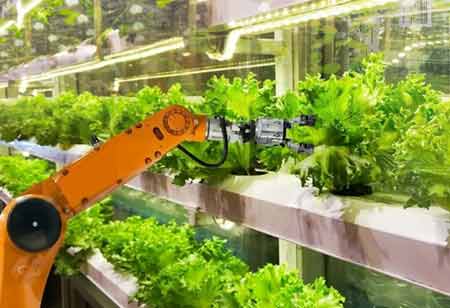Thank you for Subscribing to Agri Business Review Weekly Brief
IoT To Transforming Agricultural Sector
IoT in agriculture refers to a network in which physical components in the sector

By
Agri Business Review | Friday, March 18, 2022
Stay ahead of the industry with exclusive feature stories on the top companies, expert insights and the latest news delivered straight to your inbox. Subscribe today.
IoT in agriculture involves the network wherein physical components in the sector are connected with the internet, which may be the farms comprising trees, plants, animals, tools, and various objects in the industry.
FREMONT, CA: IoT in agriculture refers to a network in which physical components in the sector, such as farms with trees, plants, animals, tools, and other objects in the industry, are connected to the internet. Under specific regulations, this allows for information interchange, monitoring, and tracking, allowing humans to handle the complex agricultural industry more productively. Most industrialized countries, such as Germany, Japan, and the United States, have already advanced sensor technology and manufacturing techniques. Enhanced agricultural productivity, greater quality of farming products, lower labor expenses, and increased agricultural income for farmers are the net benefits of IoT implementation. Cluster IoT, distant IoT, and internal IoT are all examples of intelligent agricultural machinery or IoT. While cluster IoT focuses on communication and control between agricultural machines in the same region, remote IoT focuses on communication and management between the operation site and remote terminals and servers. Internal IoT refers to the connectivity between sensors, actuators, and the central processing unit in agricultural machinery.
IoT has a lot of applications in the agricultural sector, as practically all developing nations are aiming for a sustainable food future. The world population is anticipated to expand by 30 percent to 10 billion people by 2050, necessitating a 1.5-fold increase in agricultural productivity. The global climate stability goal includes, among other things, a 67 percent reduction in greenhouse gas emissions, which requires fixing current system flaws. There are numerous issues in the agricultural sector in developing countries, such as a lack of crop selection systems, poor irrigation systems, insufficient integration with weather forecasts, inadequate soil testing process, inefficient animal husbandry, etc.
In light of the substantial impact of water scarcity on agricultural production globally, the use of IoT allows for the selection of appropriate irrigation methods rather than the traditional flood irrigation approach, alleviating the problem of water scarcity to a large extent. IoT is also used in the monitoring and management of cattle, where IoT devices are linked to the animals on a farm to track their health and performance. The collar tags affixed to the species (which include a wireless link, actuators, sensors, and terminal equipment) aid in the delivery of temperature, health, activity, and nutrition insights on each individual cow and herd-wide data. Farmers can use this information to assess the nutritional and physiological status of their animals and ensure that they grow correctly.





